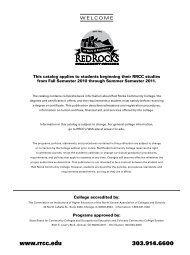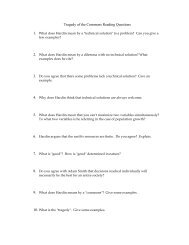opportunities, options, excellence - Red Rocks Community College
opportunities, options, excellence - Red Rocks Community College
opportunities, options, excellence - Red Rocks Community College
You also want an ePaper? Increase the reach of your titles
YUMPU automatically turns print PDFs into web optimized ePapers that Google loves.
ment scores for reading and writing, or permission<br />
of faculty advisor.<br />
This course, covers the growth and development<br />
of the child from conception through the<br />
elementary school years. Physical, cognitive,<br />
emotional, psychosocial and environmental<br />
factors are emphasized. The concept of the<br />
whole child and how adults can provide a<br />
supportive environment for children is also<br />
emphasized. This class may be taken as PSY<br />
238. Ages addressed: prenatal through age<br />
12. The co-requisite lab includes applied<br />
observation of childrens’ development.<br />
ECE 255 Working with Parents<br />
Families and <strong>Community</strong> Systems<br />
3 Credits<br />
This course covers variations in family/parenting<br />
patterns and the effects of diverse cultural<br />
communities on the development of a child.<br />
Strategies to address the whole child as a<br />
member of a family and community are<br />
emphasized. The importance of inclusion of<br />
all family and cultural variations in delivery of<br />
care for children and families is a core component<br />
of this course.<br />
ECE 260 The Exceptional Child<br />
3 Credits<br />
This course presents an overview of typical<br />
developmental progression. The content<br />
includes planning, learning strategies, legal<br />
requirements, accommodations and adaptations<br />
necessary to create an integrated classroom<br />
environment for a wide range of exceptionalities.<br />
Ages addressed: prenatal through<br />
age 8<br />
ECE 290 Innovative Communication<br />
Strategies<br />
1 Credit<br />
The purpose of this course is to help students<br />
learn the skills and techniques essential to<br />
effective interpersonal communications and<br />
practice applying these skills in their daily<br />
lives. Included in this course will be theory<br />
and practice in sending and listening skills,<br />
self-awareness, noverbal communication,<br />
problem solving and conflict reduction.<br />
ECO - ECONOMICS<br />
ECO 101 Economics of Social Issues<br />
3 Credits<br />
This course examines the major socio-economic<br />
issues of the past century. Topics<br />
include poverty, growth, education, health<br />
care, pollution and discrimination and the<br />
government’s role in regulating them.<br />
ECO 201 Principles of<br />
Macroeconomics<br />
(Core)<br />
3 Credits<br />
Macroeconomics is the study of the United<br />
States economy. The course looks at the interrelationships<br />
between households, businesses<br />
and the government. Saving and investment<br />
decisions will be explored, as well as the<br />
causes of unemployment and inflation.<br />
ECO 202 Principles of<br />
Microeconomics<br />
(Core)<br />
3 Credits<br />
Microeconomics studies the firm in-depth,<br />
and it explores the nature of costs and production.<br />
The course introduces economic models,<br />
which portray consumer behavior, competitive<br />
firms, monopolies, oligopolies and<br />
monopolistic competition.<br />
EGA - ENGINEERING<br />
GRAPHICS<br />
TECHNOLOGY—<br />
ARCHITECTURAL<br />
EGA 121 Intermediate CADD—<br />
Architectural<br />
3 Credits<br />
Prerequisite: EGT 120 or equivalent<br />
2-D residential concept drawings are created<br />
from given design parameters and appropriate<br />
specs. 2-D floor plans, cross sections and elevations<br />
are required.<br />
EGA 131 Three-Dimensional<br />
CADD—Architectural<br />
3 Credits<br />
Prerequisites: EGA 121 and EGT 130 or<br />
equivalents<br />
Advanced applications of three-dimensional<br />
construction techniques are applied to an<br />
architectural construction model. The 3-D<br />
model is constructed using current building<br />
methods, UBC and other local codes.<br />
EGA 207 Framing Methods<br />
3 Credits<br />
Prerequisite: EGA 131<br />
Applications of current building methods are<br />
applied to 3-D residential concept models.<br />
EGA 209 Roof Design<br />
3 Credits<br />
Prerequisite: EGA 207 or equivalent<br />
Applications of current residential roof framing<br />
methods are applied to 3-D residential<br />
concept models.<br />
EGA 231 Architectural<br />
Design/Drafting I<br />
6 Credits<br />
Prerequisite: EGA 131 or equivalent<br />
Fundamental understanding of building<br />
design, concepts and construction methods<br />
are developed by preparing working drawings<br />
with necessary details for framing, brick and<br />
steel construction. Four basic designs are used<br />
as models: the one story or ranch, the one and<br />
one-half story, the two story and the splitlevel.<br />
Only one design is chosen and a full set<br />
of detail drawings produced.<br />
EGA 241 Architectural<br />
Design/Drafting II<br />
6 Credits<br />
Prerequisite: EGA 231 or equivalent<br />
Ideas, sketches and layouts are used to create<br />
working drawings of a customized design<br />
with an emphasis in remodeling and renovation.<br />
Detailed construction drawings are produced<br />
using CADD two- and three-dimensional<br />
applications per AIA, UBC and local<br />
codes.<br />
EGM - ENGINEERING<br />
GRAPHICS<br />
TECHNOLOGY—<br />
MECHANICAL<br />
EGM 121 Intermediate CADD—<br />
Mechanical<br />
3 Credits<br />
Prerequisite: EGT 120 or equivalent<br />
This course requires a set of documentation<br />
production drawings. Drawings are created<br />
per ANSI/ASME Y14.5M spec. Application<br />
of 2-D, limits and fits, geometric dimensioning<br />
and tolerancing, dimensions and annotations<br />
are required.<br />
EGM 131 Three-Dimensional<br />
CADD—Mechanical<br />
3 Credits<br />
Prerequisites: EGM 121 and EGT 130 or<br />
equivalents<br />
3-D concept design models are created using<br />
as-built assemblies, layouts, sketches and<br />
existing concept designs. 2-D extractions<br />
from the 3-D models, dimensioning and<br />
annotations are required.<br />
EGM 205 Assembly and Detail<br />
GDandT<br />
3 Credits<br />
Prerequisites: EGM 131<br />
3D assembly drawings created from individual<br />
data bases. Assemblies are created using<br />
WBLOCK and XREF applications.<br />
Production drawing is created using the 2-D<br />
131 2002 - 2003 <strong>Red</strong> <strong>Rocks</strong> <strong>Community</strong> <strong>College</strong> Catalog
















